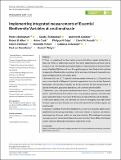Files in this item
Implementing integrated measurements of essential biodiversity variables at a national scale
Item metadata
| dc.contributor.author | Bellingham, Peter J. | |
| dc.contributor.author | Richardson, Sarah J. | |
| dc.contributor.author | Gormley, Andrew M. | |
| dc.contributor.author | Allen, Robert B. | |
| dc.contributor.author | Cook, Asher | |
| dc.contributor.author | Crisp, Philippa N. | |
| dc.contributor.author | Forsyth, David M. | |
| dc.contributor.author | McGlone, Matt S. | |
| dc.contributor.author | McKay, Meredith | |
| dc.contributor.author | MacLeod, Catriona J. | |
| dc.contributor.author | van Dam-Bates, Paul | |
| dc.contributor.author | Wright, Elaine F. | |
| dc.date.accessioned | 2020-10-09T15:30:23Z | |
| dc.date.available | 2020-10-09T15:30:23Z | |
| dc.date.issued | 2020-11 | |
| dc.identifier | 270641160 | |
| dc.identifier | 600bfd1f-f8e8-4256-a932-e90fd52ba811 | |
| dc.identifier | 85097750184 | |
| dc.identifier | 000798015600002 | |
| dc.identifier.citation | Bellingham , P J , Richardson , S J , Gormley , A M , Allen , R B , Cook , A , Crisp , P N , Forsyth , D M , McGlone , M S , McKay , M , MacLeod , C J , van Dam-Bates , P & Wright , E F 2020 , ' Implementing integrated measurements of essential biodiversity variables at a national scale ' , Ecological Solutions and Evidence , vol. 1 , no. 2 , e12025 . https://doi.org/10.1002/2688-8319.12025 | en |
| dc.identifier.issn | 2688-8319 | |
| dc.identifier.other | RIS: urn:79709E21D8866B9045BE65A4A8160355 | |
| dc.identifier.uri | https://hdl.handle.net/10023/20758 | |
| dc.description | Funding: the Strategic Science Investment Funding for Crown Research Institutes from the Ministry of Business, Innovation and Employment. | en |
| dc.description.abstract | 1. There is a global need for observation systems that deliver regular, timely data on state and trends in biodiversity, but few have been implemented, and fewer still at national scales. We describe the implementation of measurement of Essential Biodiversity Variables (EBVs) on an 8 km × 8 km grid throughout New Zealand, with multiple components of biodiversity (vegetation, birds, and some introduced mammals) measured simultaneously at each sample point. 2. Between 2011 and 2017, all public land was sampled nationally (ca. 1,350 points) and some private land (ca. 500 points). Synthetic appraisals of the state of New Zealand's biodiversity, not possible previously, can be derived from the first measurement of species distribution, population abundance, and taxonomic diversity EBVs. 3. Native bird counts (all species combined) were about 2.5 times greater per sample point in natural forests and shrublands than in non‐woody ecosystems, and native bird counts exceeded those of non‐native birds across all natural forests and shrublands. 4. Non‐native plants, birds, and mammals are invasive throughout, but high‐rainfall forested regions are least invaded, and historically deforested rain shadow regions are most invaded. 5. National reporting of terrestrial biodiversity across New Zealand's public land is established and becoming normalised, in the same manner as national and international reporting of human health and education statistics. The challenge is extending coverage across all private land. Repeated measurements of these EBVs, which began in 2017, will allow defensible estimates of biodiversity trends. | |
| dc.format.extent | 11 | |
| dc.format.extent | 2239993 | |
| dc.language.iso | eng | |
| dc.relation.ispartof | Ecological Solutions and Evidence | en |
| dc.subject | Biological invasions | en |
| dc.subject | Grid-based sampling | en |
| dc.subject | Non-native birds | en |
| dc.subject | State and trend monitoring | en |
| dc.subject | Systematic biodiversity assessment | en |
| dc.subject | GE Environmental Sciences | en |
| dc.subject | QH301 Biology | en |
| dc.subject | DAS | en |
| dc.subject | SDG 3 - Good Health and Well-being | en |
| dc.subject | SDG 15 - Life on Land | en |
| dc.subject.lcc | GE | en |
| dc.subject.lcc | QH301 | en |
| dc.title | Implementing integrated measurements of essential biodiversity variables at a national scale | en |
| dc.type | Journal article | en |
| dc.contributor.institution | University of St Andrews. Statistics | en |
| dc.identifier.doi | https://doi.org/10.1002/2688-8319.12025 | |
| dc.description.status | Peer reviewed | en |
This item appears in the following Collection(s)
Items in the St Andrews Research Repository are protected by copyright, with all rights reserved, unless otherwise indicated.

